Managing your money used to mean carrying around a checkbook and scribbling numbers in a notebook. But in today’s digital world, your entire financial life can live right in your pocket. Budgeting apps have changed the game, offering easy, accessible, and smart ways to track your income, monitor your spending, and save for the future.
Whether you’re trying to get out of debt, save for a vacation, or just figure out where your money goes every month, there’s a budgeting app out there for you. But with so many choices—from feature-packed platforms to minimalist tools—how do you know which one fits your lifestyle?
In this guide, we’ll walk you through the most popular budgeting apps, break down their features, and help you figure out which one is the best fit for your financial goals.
Why Use a Budgeting App?
Let’s face it: budgeting is not always fun. But budgeting apps aim to make it easier and, dare we say, even enjoyable. Here’s why they matter:
- Automation: Most apps sync with your bank account, categorizing your transactions automatically.
- Clarity: Visual charts and breakdowns help you understand where your money is going.
- Accountability: Real-time alerts and budget reminders keep you on track.
- Customization: Set goals, track spending by category, and even plan for future expenses.
Whether you’re a college student, a working professional, or managing a household, a good budgeting app can simplify your financial life.
1. YNAB (You Need a Budget)
Best For: People serious about gaining control of their finances.
YNAB is more than just a budgeting tool; it’s a financial philosophy. It helps you assign every dollar a job and focuses heavily on being proactive with your money.
Key Features:
- Zero-based budgeting
- Goal tracking
- Real-time syncing
- Detailed reports
Pros:
- Encourages mindful spending
- Strong community and support
- Excellent educational content
Cons:
- Steeper learning curve
- $14.99/month or $99/year (no free version)
2. Mint
Best For: Beginners looking for a free, all-in-one tool.
Mint has long been a favorite for those just getting started. It’s owned by Intuit (maker of TurboTax) and offers a broad overview of your financial picture.
Key Features:
- Free to use
- Syncs with bank accounts, credit cards, loans
- Credit score tracking
- Bill payment reminders
Pros:
- User-friendly
- Completely free
- Customizable alerts
Cons:
- Ads can be distracting
- Some syncing issues reported
3. EveryDollar
Best For: Fans of Dave Ramsey’s envelope-style budgeting.
EveryDollar uses a zero-based budgeting system and was created by Ramsey Solutions. It’s perfect for those following the “Baby Steps” financial plan.
Key Features:
- Manual entry or bank sync with paid plan
- Drag-and-drop budgeting
- Goal tracking
Pros:
- Simple and clean layout
- Encourages intentional spending
- Integrates with Financial Peace University
Cons:
- Bank syncing only available with paid plan ($79.99/year)
- Lacks investment tracking
4. Goodbudget
Best For: Couples or families who want to budget together.
Goodbudget uses the envelope method, but with a digital twist. It’s ideal for people who like the idea of physical envelopes but want the convenience of an app.
Key Features:
- Envelope-based budgeting
- Syncs across devices
- Manual transaction entry
Pros:
- Great for shared budgeting
- Free version available
- Strong focus on savings goals
Cons:
- No automatic syncing (must enter transactions manually)
- Limited envelopes with free plan
5. PocketGuard
Best For: People who overspend and need guardrails.
PocketGuard’s biggest selling point is its “In My Pocket” feature, which shows you how much you can safely spend after accounting for bills and goals.
Key Features:
- Automatic syncing
- Smart algorithms
- Bill tracking
Pros:
- Very user-friendly
- Helps control overspending
- Offers personalized tips
Cons:
- Limited customization
- Free version is basic; paid version is $7.99/month
Comparing the Top Budgeting Apps
| App | Best For | Free Version | Notable Feature |
|---|---|---|---|
| YNAB | Advanced users | No | Zero-based budgeting |
| Mint | Beginners | Yes | All-in-one dashboard |
| EveryDollar | Dave Ramsey followers | Yes | Envelope-style budgeting |
| Goodbudget | Families/couples | Yes | Sync across multiple users |
| PocketGuard | Controlling overspending | Yes | “In My Pocket” feature |
Choosing the Right App for You
Still unsure? Here are some personality-based suggestions:
- The Data Nerd: Try YNAB for in-depth reports and insights.
- The Minimalist: Go with EveryDollar or Goodbudget.
- The Free Spirit: Mint gives a wide overview without a price tag.
- The Overspender: PocketGuard puts limits in place.
You might also want to try 2 or 3 apps for a week each and see which one fits your habits and needs.
How to Make the Most of Your Budgeting App
No matter which app you choose, the key is consistency. Here are a few tips:
- Set realistic goals: Don’t aim to save half your income overnight. Start small.
- Check in weekly: Schedule a 10-minute budget date with yourself.
- Customize categories: Make your budget reflect your real lifestyle.
- Celebrate wins: Paid off a credit card? Saved $500? Acknowledge it!
Final Thoughts
Budgeting isn’t about restriction. It’s about freedom. It’s knowing where your money is going so you can tell it what to do, instead of wondering where it went.
Budgeting apps bring structure, visibility, and even excitement to managing money. Whether you want a robust planner or a simple tracker, there’s a tool out there that can support your financial goals.
So take the leap. Try one out. Your bank account will thank you.








